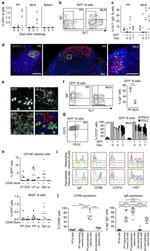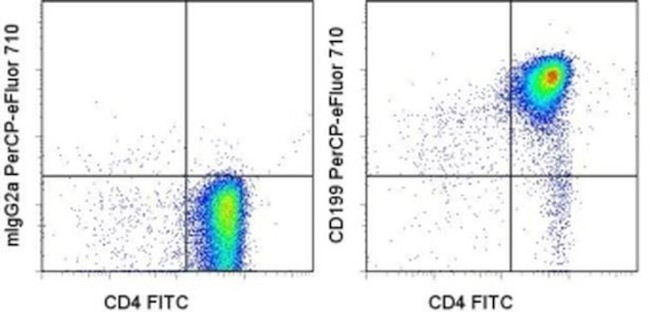Search Thermo Fisher Scientific
Invitrogen
CD199 (CCR9) Monoclonal Antibody (eBioCW-1.2 (CW-1.2)), PerCP-eFluor™ 710, eBioscience™
FIGURE: 1 / 2
CD199 (CCR9) Antibody (46-1991-82) in Flow


Product Details
46-1991-82
Species Reactivity
Published species
Host/Isotype
Recommended Isotype Control
Class
Type
Clone
Conjugate
Excitation/Emission Max
Form
Concentration
Purification
Storage buffer
Contains
Storage conditions
Shipping conditions
RRID
Product Specific Information
Description: The eBioCW-1.2 monoclonal antibody reacts with mouse CCR9 (CD199), which is the receptor for thymus-expressed chemokine (TECK). CCR9 is a member of the G protein coupled receptor (GPCR) supergene family, and is involved in trafficking of T cell progenitors within the thymus. CCR9 expression during thymocyte development commences at the double-negative (DN) 3 stage (CD4-CD8-CD25+CD44-), peaks in the double-positive (DP) stage (CD4+CD8+CD25-CD44-), and is down-regulated in commited CD4+ or CD8+ single-positive (SP) thymoyctes. CCR9-deficient mice show a mild impairment in thymoycte development. In the periphery, CCR9 is thought to be expressed on naive CD8+ T cells, but not on naive CD4+ T cells.
Applications Reported: This eBioCW-1.2 (CW-1.2) antibody has been reported for use in flow cytometric analysis.
Applications Tested: This eBioCW-1.2 (CW-1.2) antibody has been tested by flow cytometric analysis of mouse thymocytes. This can be used at less than or equal to 0.5 µg per test. A test is defined as the amount (µg) of antibody that will stain a cell sample in a final volume of 100 µL. Cell number should be determined empirically but can range from 10^5 to 10^8 cells/test. It is recommended that the antibody be carefully titrated for optimal performance in the assay of interest.
PerCP-eFluor® 710 can be used in place of PE-Cy5, PE-Cy5.5 or PerCP-Cy5.5. PerCP-eFluor® 710 emits at 710 nm and is excited with the blue laser (488 nm). Please make sure that your instrument is capable of detecting this fluorochrome. For a filter configuration, we recommend using the 685 LP dichroic mirror and 710/40 band pass filter, however the 695/40 band pass filter is an acceptable alternative.
Our testing indicates that PerCP-eFluor® 710 conjugated antibodies are stable when stained samples are exposed to freshly prepared 2% formaldehyde overnight at 4°C, but please evaluate for alternative fixation protocols.
Excitation: 488 nm; Emission: 710 nm; Laser: Blue Laser.
Filtration: 0.2 µm post-manufacturing filtered.
Target Information
The protein encoded by this gene is a member of the beta chemokine receptor family. It is predicted to be a seven transmembrane protein similar to G protein-coupled receptors. Chemokines and their receptors are key regulators of the thymocytes migration and maturation in normal and inflammation conditions. The specific ligand of this receptor is CCL25. It has been found that this gene is differentially expressed by T lymphocytes of small intestine and colon, suggested a role in the thymocytes recruitment and development that may permit functional specialization of immune responses in different segment of the gastrointestinal tract. This gene is mapped to the chemokine receptor gene cluster region. Two alternatively spliced transcript variants have been described.
For Research Use Only. Not for use in diagnostic procedures. Not for resale without express authorization.
How to use the Panel Builder
Watch the video to learn how to use the Invitrogen Flow Cytometry Panel Builder to build your next flow cytometry panel in 5 easy steps.
Bioinformatics
Protein Aliases: C-C chemokine receptor type 9; C-C CKR-9; CC-CKR-9; CCR-9; CDw199; CDw199 antigen; Chemokine C-C receptor 10
Gene Aliases: A130091K22Rik; Ccr9; Cmkbr10; GPR-9-6
UniProt ID: (Mouse) Q9WUT7
Entrez Gene ID: (Mouse) 12769

Performance Guarantee
If an Invitrogen™ antibody doesn't perform as described on our website or datasheet,we'll replace the product at no cost to you, or provide you with a credit for a future purchase.*
Learn more
We're here to help
Get expert recommendations for common problems or connect directly with an on staff expert for technical assistance related to applications, equipment and general product use.
Contact tech support

